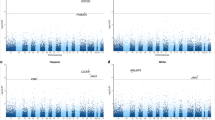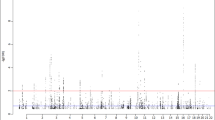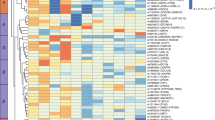Abstract
Body mass index (BMI) is a non-invasive measurement of obesity. It is commonly used for assessing adiposity and obesity-related risk prediction. Genetic differences between ethnic groups are important factors, which contribute to the variation in phenotypic effects. India inhabited by the first out-of-Africa human population and the contemporary Indian populations are admixture of two ancestral populations; ancestral north Indians (ANI) and ancestral south Indians (ASI). Although ANI are related to Europeans, ASI are not related to any group outside Indian-subcontinent. Hence, we expect novel genetic loci associated with BMI. In association analysis, we found eight genic SNPs in extreme of distribution (P⩽3.75 × 10−5), of which WWOX has already been reported to be associated with obesity-related traits hence excluded from further study. Interestingly, we observed rs1526538, an intronic SNP of THSD7A; a novel gene significantly associated with obesity (P=2.88 × 10−5, 8.922 × 10−6 and 2.504 × 10−9 in discovery, replication and combined stages, respectively). THSD7A is neural N-glycoprotein, which promotes angiogenesis and it is well known that angiogenesis modulates obesity, adipose metabolism and insulin sensitivity, hence our result find a correlation. This information can be used for drug target, early diagnosis of obesity and treatment.
This is a preview of subscription content, access via your institution
Access options
Subscribe to this journal
Receive 12 print issues and online access
$259.00 per year
only $21.58 per issue
Buy this article
- Purchase on Springer Link
- Instant access to full article PDF
Prices may be subject to local taxes which are calculated during checkout


Similar content being viewed by others
References
Kopelman PG . Obesity as a medical problem. Nature 2000; 404: 635–643.
Roth J, Qiang X, Marban SL, Redelt H, Lowell BC . The obesity pandemic: where have we been and where are we going? Obes Res 2004; 12 (Suppl 2): 88S–101S.
Wen W, Zheng W, Okada Y, Takeuchi F, Tabara Y, Hwang JY et al. Meta-analysis of genome-wide association studies in East Asian-ancestry populations identifies four new loci for body mass index. Hum Mol Genet 2014; 23: 5492–5504.
Graff M, Ngwa JS, Workalemahu T, Homuth G, Schipf S, Teumer A et al. Genome-wide analysis of BMI in adolescents and young adults reveals additional insight into the effects of genetic loci over the life course. Hum Mol Genet 2013; 22: 3597–3607.
Berndt SI, Gustafsson S, Magi R, Ganna A, Wheeler E, Feitosa MF et al. Genome-wide meta-analysis identifies 11 new loci for anthropometric traits and provides insights into genetic architecture. Nat Genet 2013; 45: 501–512.
Loos RJ, Lindgren CM, Li S, Wheeler E, Zhao JH, Prokopenko I et al. Common variants near MC4R are associated with fat mass, weight and risk of obesity. Nat Genet 2008; 40: 768–775.
Monda KL, Chen GK, Taylor KC, Palmer C, Edwards TL, Lange LA et al. A meta-analysis identifies new loci associated with body mass index in individuals of African ancestry. Nat Genet 2013; 45: 690–696.
Okada Y, Kubo M, Ohmiya H, Takahashi A, Kumasaka N, Hosono N et al. Common variants at CDKAL1 and KLF9 are associated with body mass index in east Asian populations. Nat Genet 2012; 44: 302–306.
Pei YF, Zhang L, Liu Y, Li J, Shen H, Liu YZ et al. Meta-analysis of genome-wide association data identifies novel susceptibility loci for obesity. Hum Mol Genet 2014; 23: 820–830.
Speliotes EK, Willer CJ, Berndt SI, Monda KL, Thorleifsson G, Jackson AU et al. Association analyses of 249,796 individuals reveal 18 new loci associated with body mass index. Nat Genet 2010; 42: 937–948.
Thorleifsson G, Walters GB, Gudbjartsson DF, Steinthorsdottir V, Sulem P, Helgadottir A et al. Genome-wide association yields new sequence variants at seven loci that associate with measures of obesity. Nat Genet 2009; 41: 18–24.
Willer CJ, Speliotes EK, Loos RJ, Li S, Lindgren CM, Heid IM et al. Six new loci associated with body mass index highlight a neuronal influence on body weight regulation. Nat Genet 2009; 41: 25–34.
Tan LJ, Zhu H, He H, Wu KH, Li J, Chen XD et al. Replication of 6 obesity genes in a meta-analysis of genome-wide association studies from diverse ancestries. PLoS One 2014; 9: e96149.
Reich D, Thangaraj K, Patterson N, Price AL, Singh L . Reconstructing Indian population history. Nature 2009; 461: 489–494.
Moorjani P, Thangaraj K, Patterson N, Lipson M, Loh PR, Govindaraj P et al. Genetic evidence for recent population mixture in India. Am J Hum Genet 2013; 93: 422–438.
IASO. The Asia-Pacific Perspective: Redefining Obesity and its Treatment. World Health Organization Western Pecific Region, 2000.
Korn JM, Kuruvilla FG, McCarroll SA, Wysoker A, Nemesh J, Cawley S et al. Integrated genotype calling and association analysis of SNPs, common copy number polymorphisms and rare CNVs. Nat Genet 2008; 40: 1253–1260.
Patterson N, Price AL, Reich D . Population structure and eigenanalysis. PLoS Genet 2006; 2: e190.
Purcell S, Neale B, Todd-Brown K, Thomas L, Ferreira MA, Bender D et al. PLINK: a tool set for whole-genome association and population-based linkage analyses. Am J Hum Genet 2007; 81: 559–575.
Yang J, Lee SH, Goddard ME, Visscher PM . GCTA: a tool for genome-wide complex trait analysis. Am J Hum Genet 2011; 88: 76–82.
Natarajan R, Turnbull BW, Slate EH, Clark LC . A computer program for sample size and power calculations in the design of multi-arm and factorial clinical trials with survival time endpoints. Comput Methods Programs Biomed 1996; 49: 137–147.
Wang K, Li WD, Zhang CK, Wang Z, Glessner JT, Grant SF et al. A genome-wide association study on obesity and obesity-related traits. PLoS One 2011; 6: e18939.
Been LF, Nath SK, Ralhan SK, Wander GS, Mehra NK, Singh J et al. Replication of association between a common variant near melanocortin-4 receptor gene and obesity-related traits in Asian Sikhs. Obesity (Silver Spring) 2010; 18: 425–429.
Vasan SK, Fall T, Neville MJ, Antonisamy B, Fall CH, Geethanjali FS et al. Associations of variants in FTO and near MC4R with obesity traits in South Asian Indians. Obesity (Silver Spring) 2012; 20: 2268–2277.
Kuo MW, Wang CH, Wu HC, Chang SJ, Chuang YJ . Soluble THSD7A is an N-glycoprotein that promotes endothelial cell migration and tube formation in angiogenesis. PLoS One 2011; 6: e29000.
Wang CH, Chen IH, Kuo MW, Su PT, Lai ZY, Wang CH et al. Zebrafish Thsd7a is a neural protein required for angiogenic patterning during development. Dev Dyn 2011; 240: 1412–1421.
Wang CH, Su PT, Du XY, Kuo MW, Lin CY, Yang CC et al. Thrombospondin type I domain containing 7A (THSD7A) mediates endothelial cell migration and tube formation. J Cell Physiol 2010; 222: 685–694.
Cao Y . Angiogenesis modulates adipogenesis and obesity. J Clin Invest 2007; 117: 2362–2368.
Acknowledgements
This work was supported by the Office of the Principal Scientific Advisor to Government of India; Department of Science and Technology (DST), Government of India (PRNSA/ADV/AYURVEDA/4/2007). KT was also supported by CSIR Network project—GENESIS (BSC0121), Government of India. We acknowledge the help of Dr Ketaki Bapat for her constant support throughout the project tenure.
Author information
Authors and Affiliations
Corresponding author
Ethics declarations
Competing interests
The authors declare no conflict of interest.
Additional information
Supplementary Information accompanies this paper on International Journal of Obesity website
Supplementary information
Rights and permissions
About this article
Cite this article
Nizamuddin, S., Govindaraj, P., Saxena, S. et al. A novel gene THSD7A is associated with obesity. Int J Obes 39, 1662–1665 (2015). https://doi.org/10.1038/ijo.2015.144
Received:
Revised:
Accepted:
Published:
Issue Date:
DOI: https://doi.org/10.1038/ijo.2015.144
This article is cited by
-
THSD7A expression: a novel immunohistochemical determinant in predicting overall survival of metastatic renal cell carcinoma treated with targeted therapy
Irish Journal of Medical Science (1971 -) (2022)
-
Angiogenic Potential, Circulating Angiogenic Factors and Insulin Resistance in Subjects with Obesity
Indian Journal of Clinical Biochemistry (2021)
-
Pilot GWAS of caries in African-Americans shows genetic heterogeneity
BMC Oral Health (2019)
-
Reply to ‘Lack of replication of association of THSD7A with obesity’
International Journal of Obesity (2016)



